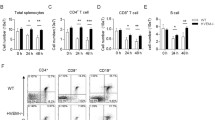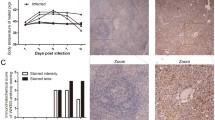Abstract
In fatal Ebola virus hemorrhagic fever massive intravascular apoptosis develops rapidly following infection and progressing relentlessly until death. While data suggest that T lymphocytes are mainly deleted by apoptosis in PBMC of human fatal cases, experimental Ebola infection in animal models have shown some evidence of destruction of lymphocytes in spleen and lymph nodes probably involving both T and B cells. Nevertheless, we are able to conclude from the accumulated evidence that early interactions between Ebola virus and the immune system, probably via macrophages, main targets for viral replication, lead to massive destruction of immune cells in fatal cases.
Similar content being viewed by others
References
Georges AJ, Leroy EM, Renaut AA, et al. Ebola hemorrhagic fever outbreaks in Gabon, 1994–1997: epidemiologic and health control issues. J Inf Dis 1999; 179(Suppl 1): 65–75.
Baize S, Leroy EM, Georges-Courbot M-C, et al. Defective humoral responses and extensive intravascular apoptosis are associated with fatal outcome in Ebola virus-infected patients. Nature Med 1999; 5: 423–426.
Miller T, Beausang LA, Meneghini M, Lidgard G. Deathinduced changes to the nuclear matrix: The use of anti-nuclear matrix antibodies to study agents of apoptosis. BioTechniques 1993; 15: 1042–1047.
World Health Organization. Ebola haemorrhagic fever in Sudan, 1976. Report of a world health organization study team. Bull WHO 1978; 56: 247–270.
Baskerville A, Fisher-Hoch SP, Neild GH, Dowsett AB. Ultrastructural pathology of experimental Ebola haemorrhagic fever virus infection. J Pathol 1985; 147: 199–209.
Fisher-Hoch SP, Platt GS, Neild GH, et al. Pathophysiology of shock and hemorrhage in a fulminating viral infection (Ebola). J Inf Dis 1985; 152: 887–894.
Ryabchikova EI, Kolesnikova LV, Luchko SV. An analysis of features of pathogenesis in two animal models of Ebola virus infection. J Inf Dis 1999; 179(Suppl I): S199–202.
Connolly BM, Steele KE, Davis KJ, et al. Pathogenesis of experimental Ebola virus infection in guinea pigs. J Inf Dis 1999; 179(Suppl I): S203–217.
Wool-Lewis RJ, Bates P. Characterization of Ebola virus entry by using pseudotyped viruses: identification of receptordeficient cell lines. J Virol 1998; 72: 3155–3160.
Sanchez A, Yang Z-Y, Xu L, Nabel GJ, Crews T, Peters CJ. Biochemical analysis of the secreted and virion glycoproteins of Ebola virus. J Virol 1998; 72: 6442–6447.
Yang Z-Y, Delgado R, Xu L, et al. Distinct cellular interactions of secreted and transmembrane Ebola virus glycoproteins. Science 1998; 279: 1034–1037.
Volchkov VE, Volchkova VA, Slenczka W, Klenk H-D, Feldmann H. Release of viral glycoproteins during Ebola virus infection. Virol 1998; 245: 110–119.
Boudet F, Lecoeur H, Gougeon M-L. Apoptosis associated with ex vivo down-regulation of Bcl-2 and up-regulation of Fas in potential cytotoxic CD8+ T lymphocytes during HIV infection. J Immunol 1996; 156: 2282–2293.
Alexander-Miller MA, Derby MA, Sarin A, Henkart PA, Berzofsky JA. Supraoptimal peptide-major histocompatibility complex causes a decrease in Bcl-2 levels and allows tumor necrosis factor ® receptor II-mediated apoptosis of cytotoxic T lymphocytes. J Exp Med 1998; 188: 1391–1399.
Gallimore A, Glithero A, Godkin A, et al. Induction and exhaustion of lymphocytic choriomeningitis virus-specific cytotoxic T lymphocytes vizualized using soluble tetrameric major histocompatibility complex class-I-peptide complexes. J Exp Med 1998; 187: 1383–1393.
Moskophidis D, Lechner F, Pircher H, Zinkernagel RM. Virus persistence in acutely infected immunocompetent mice by exhaustion of antiviral cytotoxic effector T cells. Nature 1993; 362: 758–761.
Dhein J, Walczak H, B¨aumler C, Debatin KM, Krammer PH. Autocrine T-cell suicide mediated by APO-1/(Fas/CD95). Nature 1995; 373: 438–441.
Zheng L, Fisher G, Miller RE, Peschon J, Lynch DH, Lenardo MJ. Induction of apoptosis in mature T cells by tumor necrosis factor. Nature 1995; 377: 348–351.
Liu Y, Janeway CA. Interferon ° plays a critical role in induced cell death of effector cell: a possible third mechanism of selftolerance. J Exp Med 1990; 172: 1735–1739.
Suda T, Hashimoto H, Tanaka M, Ochi T, Nagata S. Membrane Fas ligand kills human peripheral blood T lymphocytes, and soluble Fas ligand blocks the killing. J Exp Med 1997; 186: 2045–2050.
Villinger F, Rollin PE, Brar SS, et al. Markedly elevated levels of interferon (IFN)-°, IFN-®, interleukin (IL)-2, IL-10, and tumor necrosis factor-® associated with fatal Ebola virus infection. J Inf Dis 1999; 179(Suppl 1): S188–191.
Yoshida H, Sumichika H, Hamano S, et al. Induction of apoptosis of T cells by infecting mice with murine cytomegalovirus. J Virol 1995; 69: 4769–4775.
Gummuluru S, Novembre FJ, Lewis M, Gelbard HA, Dewhurst S. Apoptosis correlates with immune activation in intestinal lymphoid tissue from macaques acutely infected by a highly enteropathic simian immunodeficiency virus, SIVsmmPBj14. Virol 1996; 225: 21–32.
Summerfield A, Kn¨otig SM, McCullough KC. Lymphocyte apoptosis during classical swine fever: implication of activation-induced cell death. J Virol 1998; 72: 1853–1861.
Feldmann H, Bugany H, Mahner F, Klenk HD, Drenckhahn D, Schnittler HJ. Filovirus-induced endothelial leakage triggered by infected monocytes/macrophages. J Virol 1996; 70: 2208–2214.
Schnittler HJ, Feldmann H. Molecular pathogenesis of filovirus infections: role of macrophages and endothelial cells. In: Klenk HD, ed. Marburg and Ebola Viruses. Berlin: Springer-Verlag 1999: 175–204.
Author information
Authors and Affiliations
Rights and permissions
About this article
Cite this article
Baize, S., Leroy, E.M., Mavoungou, E. et al. Apoptosis in fatal Ebola infection. Does the virus toll the bell for immune system?. Apoptosis 5, 5–7 (2000). https://doi.org/10.1023/A:1009657006550
Issue Date:
DOI: https://doi.org/10.1023/A:1009657006550




